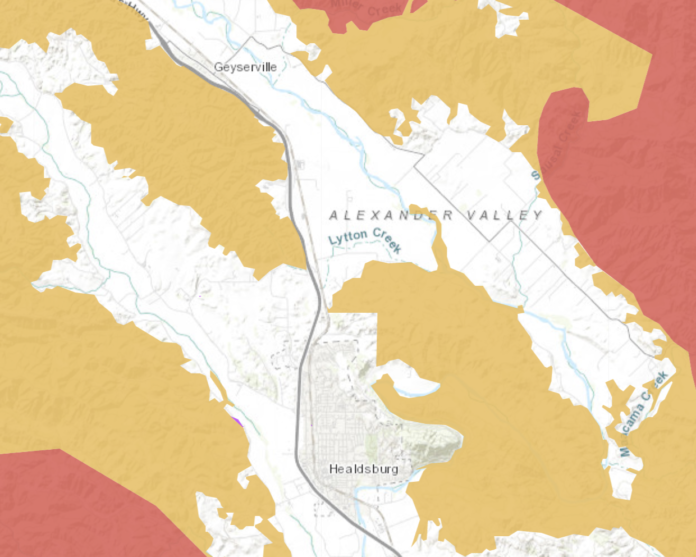
RISKY WEATHER — Darker areas indicate Tier 3 zone, which have a higher fire threat. Lighter areas are at an elevated fire risk. Image courtesy California Public Utilities Commission.
Working on notifying more people of potential shutoffs, getting power back up quicker
As wildfire season draws near, PG&E is partnering with two other power companies in California to push a wildfire awareness and safety campaign. The star of the campaign is a Public Safety Power Shutoff program, which preemptively shuts off power to people in high-fire threat areas in cases of extreme weather.
“Given the continued and growing threat of extreme weather and wildfires, and as an additional precautionary measure following the 2017 and 2018 wildfires, we are expanding and enhancing our Community Wildfire Safety Program to further reduce wildfire risks and help keep our customers and the communities we serve safe,” said Deanna Contreras, spokesperson for PG&E. “Our ongoing and expanded efforts include further enhancing vegetation management around power lines, conducting accelerated safety inspections of electric infrastructure in high fire-threat areas and hardening our electric system.”
Additionally, PG&E is expanding its Public Safety Power Shutoff program.
While the number of people and location of those that may be impacted during a power shut off depends on a variety of factors, including weather conditions and if a location is viewed as being a high-threat fire area, Contreras said that PG&E wants all customers to be prepared for a potential outage.
The people who are most likely to be considered for a potential power shut are those located in zones that are designated as being either Tier 2 (elevated risk) or Tier 3 (extreme risk) by the California Public Utilities Commission.To view CPUC’s map, visit https://ia.cpuc.ca.gov/firemap/.
Locally, the outskirts of Windsor, Healdsburg and Cloverdale are designated as both Tier 2 and Tier 3. In west county, Guerneville, Occidental are designated as Tier 3.
Learning opportunity
The Public Safety Power Shutoff program isn’t new — last year on Oct. 14, PG&E customers in Windsor, Healdsburg, Geyserville and Cloverdale were notified of a potential power shut off. The October shut off didn’t reach the full number of people who were initially warned, but it did impact 415 customers in unincorporated Sonoma County.
Based on the shut off, Contreras said that PG&E received feedback that its working on. Namely, providing better communication about the power shut off process.
“It was a learning process for everybody,” she said. “We had a lot of meetings and welcomed feedback and we’re still listening to feedback on where we could improve our communication processes (and) reducing the amount of time that it takes for the power to be restored. If there is a power safety shutoff event, we’re aiming to restart the power within 24 to 48 hours (of the weather event ending).”
After the extreme weather conditions have passed, PG&E is unable to turn the lines back on right away. Before the lines get turned back on, PG&E has to inspect “every mile of every line” to make sure that there’s nothing on the line, and that none of them are damaged, Contreras said.
“A lot of feedback we received is that we need to communicate that better,” she said. “This year we are notifying all of our customers, but they should always be prepared for a power outage. In this case this year because the power safety shutoff program has expanded, we’re asking customers to be prepared for three to five days without.”
Power-driven medical equipment
“We understand that this is an incredible hardship; we understand that people rely on power,” Contreras said. “Those who are vulnerable customers who rely on electricity for medical equipment or a health issue, we’re giving them an extra layer of communication.”
If a PG&E customer is enrolled in the company’s Medical Baseline Program, which designates them as a customer who have special energy needs because of health conditions, then PG&E will make a concentrated effort to verify that the customer knows the power will be shut off.
As part of PG&E’s notification processes, they’ll notify all customers of a potential outage however they choose to be notified (visit pge.com/mywildfirealerts to pick your preference). On the notification, there will be a way for the receiving party to confirm that they received the warning.
For customers of the Medical Baseline Program, if the recipient of the warning doesn’t respond, Contreras said that someone will go out and make sure they know that their power is at risk for being shut off.
What contributes to a shut off?
“No single factor drives a Public Safety Power Shutoff, as each situation is unique,” Contreras said. “PG&E carefully reviews a combination of many criteria when determining if power should be turned off for safety.”
Some factors that may contribute to a power shut off include a red flag warning, low humidity levels, forecasted winds over 25 mph and gusts in excess of 45 mph, the state of vegetation and on-the-ground observations from PG&E.
How to prepare
To prepare for the possibility of a power shut off, PG&E is recommending that customers take some time to think about what they may need in the case of a potentially three to five day power outage.
Some of the suggested steps include: identifying backup charging methods for phones and keeping hard copies of emergency phone numbers; have a back-up plan for medical needs and livestock; restock emergency kits; know how to manually open garage doors.
“Our goal, dependent on weather, is to send customer alerts at 48 hours, 24 hours and just prior to shutting off power,” Contreras said. “We will do so through automated calls, texts and emails. The cadence and frequency of notifications will depend, however, on the forecasted extreme weather conditions and how quickly those threats change, among other factors. We will also use pge.com and social media channels, and we will keep local news and radio outlets informed and updated.”
To update your contact information with PG&E, visit pge.com/mywildfirealerts.








